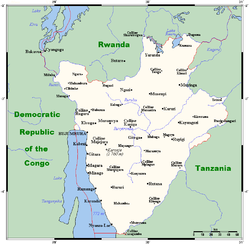Geography of Burundi
 
|
|
| Continent | Africa |
|---|---|
| Region | Central Africa |
| Coordinates | 3°30′S 30°0′E / 3.500°S 30.000°E |
| Area | Ranked 142nd |
| • Total | 27,830 km2 (10,750 sq mi) |
| • Land | 92.2% |
| • Water | 12.8% |
| Coastline | 0 km (0 mi) |
| Borders | 1,140 km (DRC 236 km, Rwanda 315 km, Tanzania 589 km) |
| Highest point | Mount Heha 2670 m |
| Lowest point | Lake Tanganyika 772 m |
| Largest lake | Lake Tanganika |
Burundi is located in central Africa, to the east of the Democratic Republic of the Congo, at the co-ordinates 3°30′S 30°0′E / 3.500°S 30.000°E.
Burundi occupies an area equal to 27,830 square kilometres (10,750 sq mi) in size, of which 25,680 square kilometres (9,920 sq mi) is land. The country has 1,140 kilometres (710 mi) of land border: 236 kilometres (147 mi) of which is shared with the Democratic Republic of the Congo, 315 kilometres (196 mi) with Rwanda and 589 kilometres (366 mi) with Tanzania. As a landlocked country, Burundi possesses no coastline. It straddles the crest of the Congo-Nile Divide which separates the basins of the Congo and Nile rivers. The farthest headwaters of the Nile, the Ruvyironza River, has its source in Burundi.
Burundi in general has a tropical highland climate, with a considerable daily temperature range in many areas. Temperature also varies considerably from one region to another, chiefly as a result of differences in altitude. The central plateau enjoys pleasantly cool weather, with an average temperature of 20 °C (68 °F). The area around Lake Tanganyika is warmer, averaging 23 °C (73.4 °F); the highest mountain areas are cooler, averaging 16 °C (60.8 °F). Bujumbura’s average annual temperature is 23 °C (73.4 °F). Rain is irregular, falling most heavily in the northwest. Dry seasons vary in length, and there are sometimes long periods of drought. However, four seasons can be distinguished: the long dry season (June–August), the short wet season (September–November), the short dry season (December–January), and the long wet season (February–May). Most of Burundi receives between 1,300 and 1,600 mm (51.2 and 63.0 in) of rainfall a year. The Ruzizi Plain and the northeast receive between 750 and 1,000 mm (29.5 and 39.4 in)
...
Wikipedia
